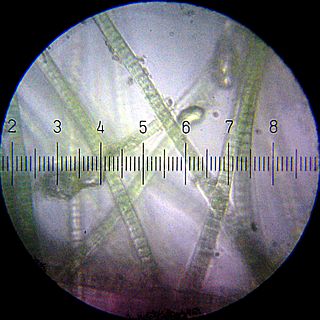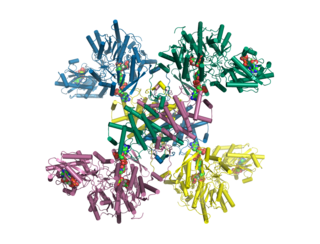
Nicotinamide adenine dinucleotide (NAD) is a coenzyme central to metabolism. Found in all living cells, NAD is called a dinucleotide because it consists of two nucleotides joined through their phosphate groups. One nucleotide contains an adenine nucleobase and the other, nicotinamide. NAD exists in two forms: an oxidized and reduced form, abbreviated as NAD+ and NADH (H for hydrogen), respectively.

Biological carbon fixation or сarbon assimilation is the process by which inorganic carbon is converted to organic compounds by living organisms. The compounds are then used to store energy and as structure for other biomolecules. Carbon is primarily fixed through photosynthesis, but some organisms use a process called chemosynthesis in the absence of sunlight.

6-Phosphogluconate dehydrogenase (6PGD) is an enzyme in the pentose phosphate pathway. It forms ribulose 5-phosphate from 6-phosphogluconate:
Carbamoyl phosphate synthetase (glutamine-hydrolysing) is an enzyme that catalyzes the reactions that produce carbamoyl phosphate in the cytosol. Its systemic name is hydrogen-carbonate:L-glutamine amido-ligase .
In enzymology, a hydrogen:quinone oxidoreductase (EC 1.12.5.1) is an enzyme that catalyzes the chemical reaction
In enzymology, a citrate—CoA ligase is an enzyme that catalyzes the chemical reaction

In enzymology, a trypanothione synthase (EC 6.3.1.9) is an enzyme that catalyzes the chemical reaction
In enzymology, an iron-chelate-transporting ATPase (EC 3.6.3.34) is an enzyme that catalyzes the chemical reaction
In enzymology, a lipopolysaccharide-transporting ATPase (EC 3.6.3.39) is an enzyme that catalyzes the chemical reaction
In enzymology, a maltose-transporting ATPase (EC 3.6.3.19) is an enzyme that catalyzes the chemical reaction
In enzymology, a manganese-transporting ATPase (EC 3.6.3.35) is an enzyme that catalyzes the chemical reaction
In enzymology, a Na+-exporting ATPase (EC 3.6.3.7) is an enzyme that catalyzes the chemical reaction
In enzymology, an oligopeptide-transporting ATPase (EC 3.6.3.23) is an enzyme that catalyzes the chemical reaction
In enzymology, an oligosaccharide-transporting ATPase (EC 3.6.3.18) is an enzyme that catalyzes the chemical reaction
In enzymology, a protein-secreting ATPase (EC 3.6.3.50) is an enzyme that catalyzes the chemical reaction
In enzymology, a teichoic-acid-transporting ATPase (EC 3.6.3.40) is an enzyme that catalyzes the chemical reaction
In enzymology, a Zn2+-exporting ATPase (EC 3.6.3.5) is an enzyme that catalyzes the chemical reaction

ATP citrate synthase (also ATP citrate lyase (ACLY)) is an enzyme that in animals represents an important step in fatty acid biosynthesis. By converting citrate to acetyl-CoA, the enzyme links carbohydrate metabolism, which yields citrate as an intermediate, with fatty acid biosynthesis, which consumes acetyl-CoA. In plants, ATP citrate lyase generates cytosolic acetyl-CoA precursors of thousands of specialized metabolites, including waxes, sterols, and polyketides.
Hydrogenobacter thermophilus is an extremely thermophilic, straight rod (bacillus) bacterium. TK-6 is the type strain for this species. It is a Gram negative, non-motile, obligate chemolithoautotroph. It belongs to one of the earliest branching order of Bacteria. H. thermophilus TK-6 lives in soil that contains hot water. It was one of the first hydrogen oxidizing bacteria described leading to the discovery, and subsequent examination of many unique proteins involved in its metabolism. Its discovery contradicted the idea that no obligate hydrogen oxidizing bacteria existed, leading to a new understanding of this physiological group. Additionally, H. thermophilus contains a fatty acid composition that had not been observed before.
Acetophenone carboxylase (EC 6.4.1.8) is an enzyme with systematic name acetophenone:carbon-dioxide ligase (ADP-forming). This enzyme catalyses the following chemical reaction





